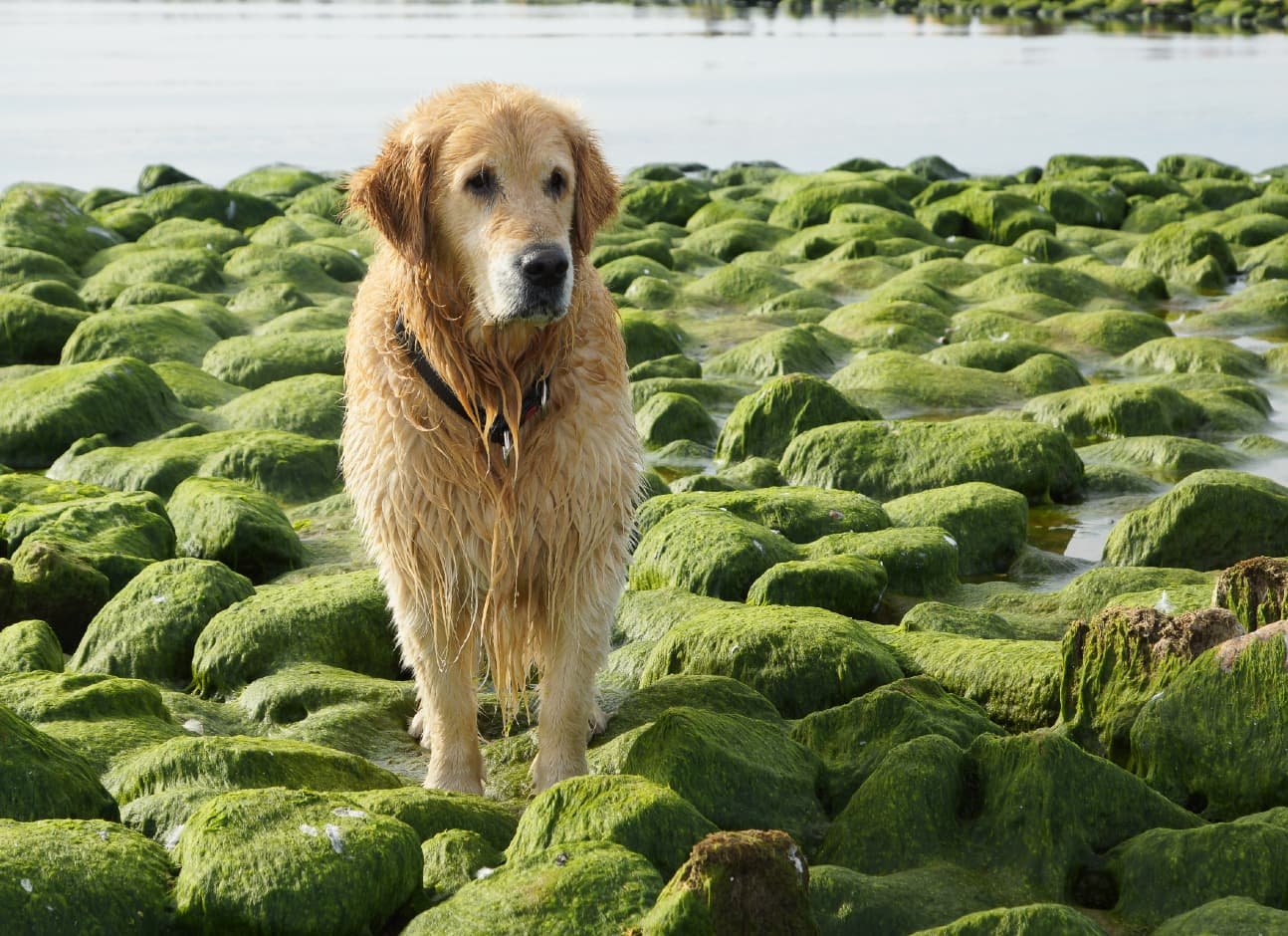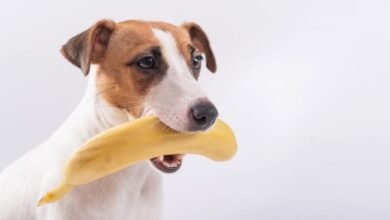
Can Dogs Eat Sea Moss? Sea moss, also known as Irish moss, is a type of natural seaweed that has gained popularity for its impressive health benefits. Packed with essential nutrients like iodine, iron, calcium, and potassium, it’s commonly used in human diets to boost overall health and wellness.
But can this nutrient-rich seaweed be a safe and healthy addition to your dog’s diet? In this article, we’ll take a closer look at what sea moss is, its potential benefits for dogs, and what you need to consider before feeding it to your pet. Let’s find out if this superfood is suitable for your furry friend! Now let’s discuss briefly that- Can Dogs Eat Sea Moss?
Can Dogs Eat Sea Moss?
Yes, dogs can eat sea moss, but it’s important to follow certain guidelines to ensure it’s safe for them. Sea moss, also known as Irish moss, is a type of seaweed that is rich in nutrients and may offer some health benefits when fed to dogs in moderation. However, it must be handled with care, as there are certain risks associated with improper use.
Key Considerations for Feeding Sea Moss to Dogs:
- Moderation is Crucial: While sea moss is packed with beneficial nutrients, it should be introduced to your dog’s diet in small, controlled amounts. Excessive consumption can lead to iodine toxicity, digestive issues, or other health concerns. For most dogs, small amounts mixed with their regular food are sufficient.
- Proper Preparation: Sea moss should always be organic, additive-free, and thoroughly rinsed before being given to your dog. Sea moss harvested from unregulated sources might contain harmful chemicals, salt, or contaminants. Rinsing helps remove any debris, sand, or salt that could be harmful to your dog.
- Gradual Introduction: Just like with any new food, it’s essential to introduce sea moss gradually into your dog’s diet. This allows you to monitor how your dog reacts to it and check for any signs of allergic reactions, digestive discomfort, or sensitivities. Start with a small portion and observe your dog’s response before increasing the quantity.
Health Benefits of Sea Moss for Dogs:
Sea moss offers several potential health benefits when fed in the right amounts:
- Nutritional Enrichment: Sea moss is a rich source of essential vitamins and minerals, including iodine, calcium, magnesium, and potassium. These nutrients can help support your dog’s overall health and vitality.
- Boosts Immune System: The antioxidants in sea moss may help strengthen the immune system, reducing your dog’s vulnerability to common illnesses and infections.
- Aids Digestion: Sea moss contains fiber, which supports digestive health by promoting regular bowel movements and improving gut health. This can be particularly helpful for dogs with occasional digestive issues.
- Skin and Coat Health: The omega-3 fatty acids found in sea moss can contribute to a shiny coat and healthy skin. These fatty acids may also help with dryness or irritation in the skin.
Risks and When to Avoid Feeding Sea Moss to Dogs:
Despite its benefits, there are some risks to consider:
- Iodine Toxicity: Sea moss is high in iodine, which supports thyroid function. However, overfeeding sea moss can lead to iodine toxicity, causing thyroid imbalances in dogs. It’s important to stick to small amounts and monitor for any signs of thyroid issues.
- Contaminants: Sea moss harvested from unregulated sources may contain heavy metals, toxins, or pollutants from the ocean, which can be harmful to your dog. Always ensure that the sea moss you use is sourced from reputable suppliers and is free of contaminants.
- Allergies or Sensitivities: Some dogs may have sensitivities to seaweed or specific compounds in sea moss. Common signs of an allergic reaction include vomiting, diarrhea, or itching. If you notice any of these symptoms, discontinue feeding sea moss and consult your vet.
- Thyroid Disorders or Iodine Sensitivities: Dogs with thyroid problems or iodine sensitivity should not consume sea moss, as it can exacerbate existing conditions. Always consult your vet before adding new foods like sea moss to your dog’s diet, especially if they have a medical condition.
How to Feed Sea Moss to Dogs Safely:
To ensure that sea moss is safely incorporated into your dog’s diet:
- Choose High-Quality Sea Moss: Opt for organic, high-quality sea moss that is free from additives, preservatives, and contaminants. Avoid flavored or processed sea moss products, as they may contain harmful ingredients.
- Thoroughly Rinse Sea Moss: Always rinse sea moss thoroughly to remove salt, sand, or debris that could potentially harm your dog. Salt, in particular, can be dangerous for dogs in large amounts.
- Serve in Small Amounts: Add small portions of sea moss to your dog’s food. A little goes a long way, and serving it occasionally as a supplement is generally recommended rather than making it a regular part of their diet.
When to Avoid Giving Sea Moss to Your Dog:
- Thyroid Problems or Iodine Sensitivity: Dogs with thyroid disorders or known sensitivities to iodine should avoid sea moss. The high iodine content could disrupt thyroid function and cause further health problems.
- Pre-existing Health Conditions: If your dog has digestive problems, allergies, or other health conditions, consult your veterinarian before adding sea moss to their diet.
- Puppies or Senior Dogs: If your dog is a puppy or a senior, they may have more sensitive digestive systems. In these cases, it’s important to consult with your vet first before introducing sea moss or other new foods.
Sea moss can be a healthy addition to your dog’s diet when prepared and served correctly. It offers several nutritional benefits, including boosting immunity, aiding digestion, and supporting skin and coat health. However, moderation and careful preparation are essential to avoid potential risks like iodine toxicity and contamination. Always introduce it gradually, observe your dog’s reaction, and consult your veterinarian if you’re uncertain about its suitability for your pet.
Potential Benefits of Sea Moss for Dogs
Sea moss can be a valuable addition to your dog’s diet when given in moderation. Packed with essential nutrients, it may provide several health benefits that support overall wellness. Let’s explore the key advantages of incorporating sea moss into your dog’s diet.
1. Rich in Nutrients
Sea moss is loaded with essential vitamins and minerals that can contribute to your dog’s overall health. These include:
- Iodine: Supports healthy thyroid function.
- Calcium: Essential for strong bones and teeth.
- Magnesium: Plays a role in muscle function and energy production.
- Potassium: Helps maintain healthy cell function and fluid balance.
These nutrients help keep your dog healthy and support various bodily functions, contributing to their general well-being.
2. Improves Digestion
Sea moss contains dietary fiber, which is beneficial for your dog’s digestive health. The fiber in sea moss:
- Promotes regular bowel movements: Helping prevent constipation.
- Supports gut health: Aiding in the balance of healthy bacteria in the digestive system.
- Reduces bloating and discomfort: Fiber can help prevent digestive upset when given in proper amounts.
This makes sea moss a potential aid for dogs with sensitive stomachs or mild digestive issues.
3. Boosts Immunity
The antioxidants found in sea moss can help boost your dog’s immune system. These antioxidants work to:
- Neutralize free radicals: Protecting the body from oxidative stress that could weaken the immune system.
- Enhance overall immunity: Helping your dog fight off illnesses and infections more effectively.
By supporting the immune system, sea moss can play a role in helping your dog stay healthy and resilient to common health issues.
4. Promotes a Healthy Coat
Sea moss is rich in omega-3 fatty acids, which are crucial for maintaining a healthy skin and coat. These omega-3s:
- Promote shiny, healthy fur: Helping maintain your dog’s coat’s luster and softness.
- Prevent dry or flaky skin: Omega-3s help keep the skin hydrated and reduce irritation.
- Support overall skin health: Helping to address conditions like itching or skin rashes.
If your dog suffers from dry skin or has a dull coat, sea moss could help improve the condition of their fur, making it shinier and healthier.
Incorporating sea moss into your dog’s diet can offer multiple health benefits, from improving digestion to boosting the immune system and promoting a healthy coat. However, as with any supplement, it’s important to feed it in moderation and monitor for any adverse reactions. Always consult with a veterinarian before introducing new foods to your dog’s diet, especially if they have pre-existing conditions.
Risks of Feeding Sea Moss to Dogs
While sea moss can provide various health benefits for dogs, it’s important to be aware of the potential risks associated with feeding it. Understanding these risks can help you make informed decisions about whether to incorporate sea moss into your dog’s diet.
1. Thyroid Issues
One of the primary risks of feeding sea moss to dogs is its high iodine content. Iodine is essential for thyroid function, but too much can cause issues. If your dog consumes excessive iodine, it may:
- Disrupt thyroid function: Leading to conditions such as hypothyroidism or hyperthyroidism.
- Cause imbalances in metabolism: Which can result in weight gain, lethargy, or other thyroid-related problems.
To avoid this risk, ensure that sea moss is given in moderation and consult your veterinarian, especially if your dog has any thyroid issues.
2. Heavy Metal Contamination
Sea moss, particularly from unregulated or poor-quality sources, may contain harmful toxins, such as heavy metals. These contaminants can pose serious risks to your dog’s health, leading to:
- Toxicity: Prolonged exposure to heavy metals can lead to organ damage, particularly affecting the liver and kidneys.
- Digestive issues: Contaminated sea moss may also cause gastrointestinal discomfort or poisoning.
Always choose organic, high-quality sea moss from reputable sources to minimize this risk.
3. Digestive Upset
While sea moss can support digestion in small amounts, feeding your dog too much may have the opposite effect. Excessive fiber can cause:
- Diarrhea: Too much fiber can overwhelm your dog’s digestive system, leading to loose stools.
- Bloating and gas: Overfeeding may cause bloating, discomfort, and excessive gas.
- Stomach cramps: Sensitive dogs may experience stomach pain if they ingest too much sea moss.
Start with small portions and gradually introduce sea moss into your dog’s diet to help prevent digestive issues. Monitor for any adverse reactions, and adjust the amount accordingly.
While sea moss offers numerous health benefits, it’s important to be aware of the potential risks. To avoid complications such as thyroid imbalances, contamination, and digestive upset, feed sea moss in moderation and choose high-quality products. Always consult your veterinarian before adding any new foods to your dog’s diet, especially if your pet has underlying health concerns.
How to Safely Introduce Sea Moss to Your Dog
Introducing new foods to your dog’s diet should always be done with care. Sea moss, while beneficial, needs to be introduced slowly and in controlled amounts to ensure your dog can tolerate it. Here’s how you can safely add sea moss to your dog’s meals.
1. Wash Sea Moss Thoroughly
Before serving sea moss to your dog, it’s essential to rinse it properly. This helps remove:
- Salt: Sea moss can sometimes contain high amounts of salt, which can be harmful to your dog.
- Impurities and debris: Washing will also help remove any sand, dirt, or other contaminants that could be present in the sea moss.
Ensure that the sea moss is thoroughly cleaned to avoid introducing unnecessary chemicals or toxins into your dog’s system.
2. Serve in Small Portions
When first introducing sea moss, start with small portions mixed into your dog’s regular food. This allows you to monitor your dog’s response to the new addition. Keep these points in mind:
- Moderation is key: Too much sea moss can cause digestive upset. Begin with a tiny amount and gradually increase the portion size.
- Mix with regular food: Combining it with your dog’s usual food can help ease them into the new ingredient.
This gradual introduction helps prevent sudden digestive issues and allows you to track any reactions.
3. Monitor for Allergic Reactions or Digestive Changes
After introducing sea moss, keep a close eye on your dog for any signs of allergies or digestive discomfort. Possible symptoms to watch for include:
- Vomiting or diarrhea: If your dog experiences these, it may indicate that the sea moss isn’t agreeing with them.
- Skin irritation or itching: This could suggest an allergic reaction to sea moss.
- Lethargy or unusual behavior: Any changes in your dog’s usual activity levels might indicate that they’re having trouble with the new food.
If you notice any adverse effects, discontinue the sea moss and consult your veterinarian for guidance.
Introducing sea moss to your dog’s diet should be done carefully and thoughtfully. Wash it thoroughly, serve in small portions, and monitor for any adverse reactions. Gradual introduction will help ensure that your dog can safely benefit from the nutritional advantages of sea moss without experiencing any negative side effects. Always consult your vet if you have concerns about introducing new foods.
When to Avoid Giving Sea Moss to Dogs
While sea moss can be a nutritious supplement for many dogs, there are certain situations where it may not be suitable. It’s essential to consider your dog’s health status and the quality of the sea moss before introducing it to their diet.
1. Dogs with Pre-Existing Thyroid Conditions or Iodine Sensitivities
Sea moss is naturally high in iodine, which can be beneficial in small amounts. However, too much iodine can interfere with thyroid function. If your dog has a thyroid condition or sensitivity to iodine, adding sea moss to their diet could exacerbate the issue. It’s essential to:
- Consult a veterinarian before introducing sea moss if your dog has thyroid issues.
- Avoid sea moss if your dog has an iodine sensitivity to prevent further complications.
2. If You’re Unsure About the Source or Quality of the Sea Moss
The quality of sea moss can vary, and poor-quality sea moss may contain harmful contaminants such as heavy metals. Always ensure that the sea moss you offer your dog is:
- Organic and additive-free: Choose trusted, reputable sources to avoid harmful chemicals.
- Thoroughly washed: Properly rinse the sea moss to remove salt, sand, and potential pollutants.
If you cannot verify the source and quality, it’s safer to avoid giving sea moss to your dog.
3. Always Consult Your Veterinarian Before Introducing New Foods
Introducing new foods like sea moss should always be done with professional guidance, especially if your dog has a history of health issues. A veterinarian can help you:
- Determine if sea moss is appropriate for your dog based on their health condition.
- Advise on portion sizes and how to gradually introduce new foods.
- Your vet will provide personalized advice to ensure your dog’s safety and well-being.
Conclusion
While sea moss offers potential health benefits for many dogs, it’s important to avoid it in certain cases, such as if your dog has thyroid issues, iodine sensitivities, or if you’re unsure of the sea moss’s quality. Always consult your veterinarian before introducing any new foods into your dog’s diet to ensure they remain healthy and safe.




